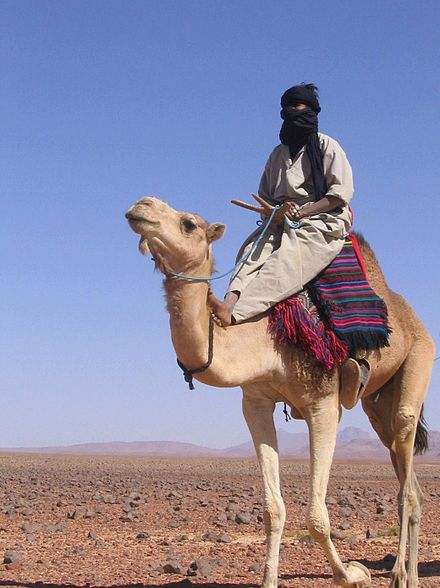Sahara - desert on the African continent

Other than the vast expanses of ice desert in the Antarctic and Arctic, the Sahara, encompassing most of northern Africa, is the world's largest desert.
Countries and territories
North Africa
- Algeria (Saharan Algeria, Saharan Atlas)
- Egypt (Western Desert)
- Libya (Saharan Libya)
- Morocco (Saharan Morocco)
- Tunisia (Saharan Tunisia)
- Western Sahara
Sahel
- Chad (Saharan Chad)
- Mali (Timbuktu Region)
- Mauritania (Saharan Mauritania)
- Niger (Northern Niger)
- Sudan (Darfur, Northern Sudan)
Cities
- Ghadamis — old town in an oasis, with whitewashed buildings and covered streets
- Ghat — fortress town; surrounding desert features some ancient rock paintings depicting animals gone long since extinct in the area
- M'Hamid — camel trips into the desert can be arranged from this Moroccan village
- Tamanrasset — oasis town in Algerian Sahara; starting point for trips further into the desert
- Timbuktu — famed city made fully of mud once on the southern end of the trans-Saharan trade routes
Other destinations
- M'zab — almost surrealistic desert fortresses scattered on a plateau
- Western Oases 📍 — five oases deep in the harsh and unforgiving Egyptian part of the desert
Understand
At 9,400,000 sq km (3,600,000 sq mi), the vastness of the Sahara is comparable to the surface area of the United States of America or China. Its name unsurprisingly derived from the plural form of the Arabic word for "desert", sahara. Despite what you may have heard big parts of the Sahara are actually not covered in sand.
Get in
Tamanrasset, Timbuktu, and Sabha are some of the Saharan towns that have air connections with elsewhere on the planet. The western and eastern edges of the desert are relatively easier to approach over land: the highway following the Atlantic coast from Morocco through Western Sahara to Mauritania was the route of the former Paris–Dakar Rally, while the Nile provides a great and traditional way of getting to the desert on a felucca. Timbuktu is also accessible with a boat ride on the Niger River from Mopti. One of the most adventurous ways of heading into the Sahara, though, is to take the Mauritania Railway from the Atlantic port of Nouadhibou, possibly in one of the iron ore cars of the longest train of the world, which runs on one of the very few railway lines in the Sahara. If that doesn't sound adventurous enough, try cycling along the western edge of the desert; the cycling the Western Sahara article provides descriptions for the route down to the Senegalese border.
Get around

All routes cross the desert in the north–south direction, and there is no through route following the path of the sun. However, most of the existing trans-Saharan routes are very isolated, unsafe due to the armed groups operating in the area, and are subject to closures due to political instability and the tense relations between the regional governments.
See
- The vast sand dunes
- Rock art
- Oases
Do
Festivals
The Tunisian town of Douz holds the four-day Sahara Festival towards the end of each year, celebrating the desert culture, featuring camel riding displays, poetry readings, and traditional music and dance shows.
If you opt for a more politically loaded gathering, though, you may want to check out the Sahara International Film Festival (or FiSahara), which annually takes place in Sahrawi refugee camps (inhabited by refugees escaping from the conflict between Morocco and Polisario/SADR in Western Sahara), near the Algerian border town of Tindouf during the spring.
Eat
Drink
Stay safe
Go next
To the north, the Sahara hugs the Mediterranean coast or ends at the foothills of the Atlas Mountains, while to the south it gradually morphes into the relatively more vegetated Sahel.